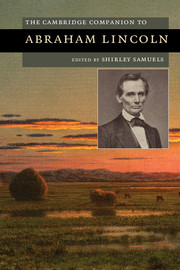Book contents
- Frontmatter
- Introduction
- 1 Rhetorically Lincoln: Abraham Lincoln and Oratorical Culture
- 2 Abraham Lincoln and Poetry
- 3 Seeing Lincoln: Visual Encounters
- 4 Lincoln's Gettysburg Address and Second Inaugural Address
- 5 Lincoln and the Natural Nation
- 6 Abraham Lincoln and the American Indians
- 7 Abraham Lincoln and the Self-Governing Constitution
- 8 Abraham Lincoln and Spiritual Crisis
- 9 America and Britain during the Civil War
- 10 Lincoln in International Memory
- 11 Lincoln's Hemispheric Relations
- 12 Lincoln on Hallowed Ground
- Guide to Further Reading
- Index
6 - Abraham Lincoln and the American Indians
Published online by Cambridge University Press: 28 September 2012
- Frontmatter
- Introduction
- 1 Rhetorically Lincoln: Abraham Lincoln and Oratorical Culture
- 2 Abraham Lincoln and Poetry
- 3 Seeing Lincoln: Visual Encounters
- 4 Lincoln's Gettysburg Address and Second Inaugural Address
- 5 Lincoln and the Natural Nation
- 6 Abraham Lincoln and the American Indians
- 7 Abraham Lincoln and the Self-Governing Constitution
- 8 Abraham Lincoln and Spiritual Crisis
- 9 America and Britain during the Civil War
- 10 Lincoln in International Memory
- 11 Lincoln's Hemispheric Relations
- 12 Lincoln on Hallowed Ground
- Guide to Further Reading
- Index
Summary
On December 26, 1862, the Dakota Uprising ended when thirty-eight Dakota men were simultaneously executed at Mankato, Minnesota. They had been convicted of murder and rape in trials that lasted as little as five minutes, and the trials were conducted in a language – English – that most of the accused could not speak. It was and remains the largest mass execution in United States history. However, originally almost seven times as many men were scheduled to die. Military tribunals in Minnesota sentenced a total of 303 prisoners to death and sent the verdicts to Washington for the approval of the president of the United States, Abraham Lincoln. After almost a month of deliberation, Lincoln acquitted 265 of the prisoners. The new, diminished number enraged many white Minnesotans. Nevertheless, a crowd of thousands gathered around a mass gallows to watch the Dakota men – who spent the moments before the trap fell dancing in their nooses and shouting their names – plunge to their deaths. The day after the hangings, the marshal of the prison went to release Chaska, one of the many men whom Lincoln had acquitted. “I went to the prison to release a man who had been acquitted for saving a woman's life, but when I asked for him, the answer was, ‘He is not here; you hung him yesterday.’ I could not bring back the redskin.”
- Type
- Chapter
- Information
- The Cambridge Companion to Abraham Lincoln , pp. 91 - 107Publisher: Cambridge University PressPrint publication year: 2012



